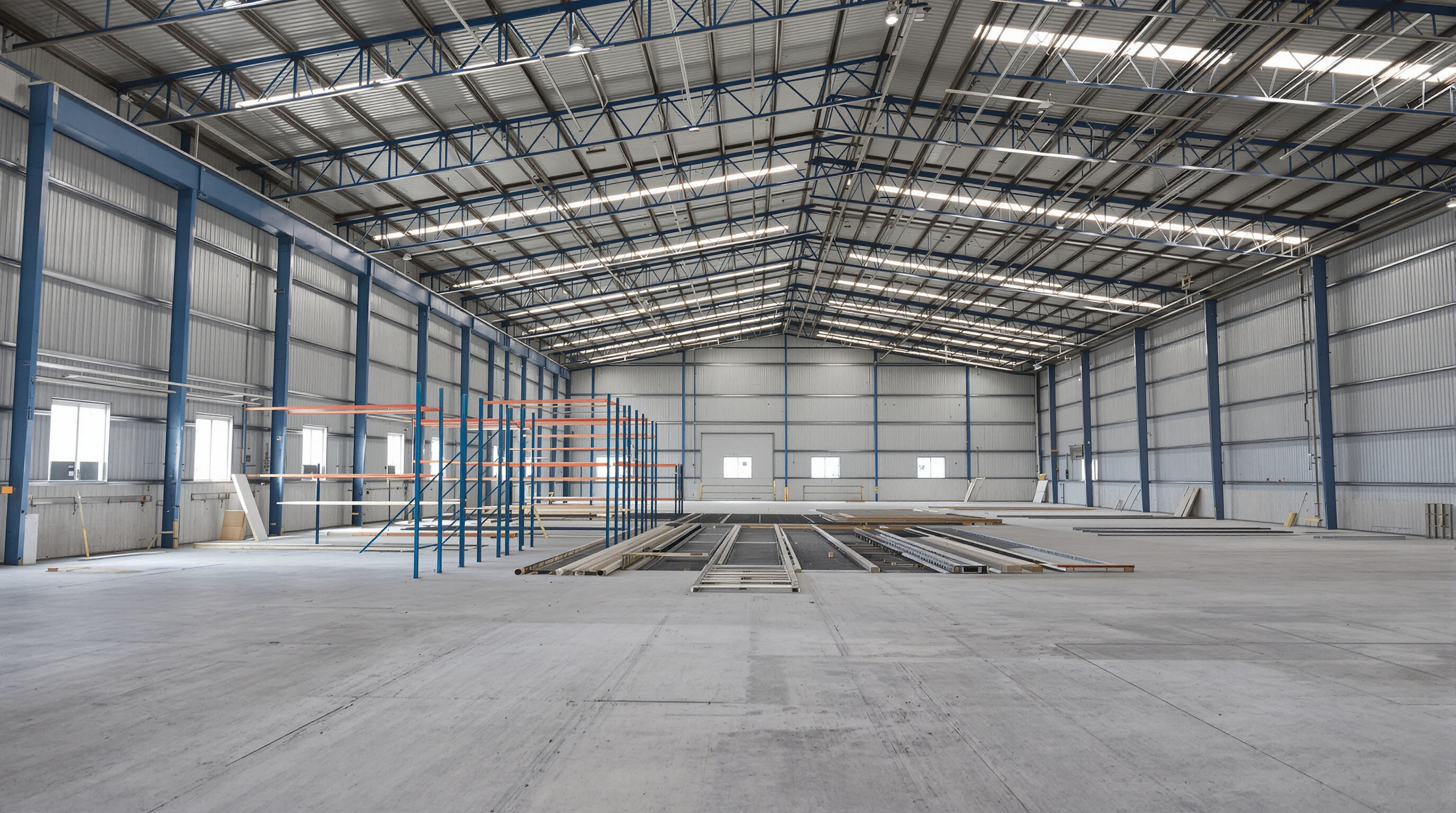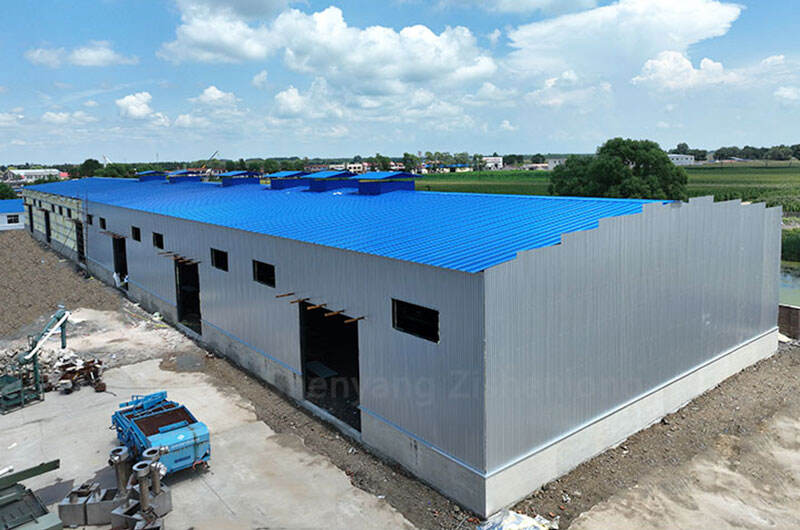Comprendre le compromis entre la capacité de stockage et le coût d'un entrepôt en acier

Le défi d'équilibrer la capacité de stockage et le coût dans les projets d'entrepôts en acier
Lorsque des entreprises souhaitent agrandir leur espace de stockage, elles finissent généralement par payer entre 18 et 25 pour cent de plus par pied carré supplémentaire pour une construction d'entrepôt en acier, selon ce que des experts du secteur ont indiqué en 2023. Et c'est ici que les choses se compliquent. Construire trop d'espace dès le départ peut entraîner un gaspillage de plus de 740 000 dollars par an, rien que sur des surfaces vides, comme indiqué dans l'étude Ponemon de l'année dernière. En revanche, si les entreprises ne construisent pas suffisamment au départ, elles se retrouveront probablement à devoir entreprendre des rénovations coûteuses cinq à sept ans plus tard. Pour bien évaluer la situation, il est nécessaire d'examiner plusieurs facteurs ensemble. Premièrement, jusqu'à quelle hauteur pouvons-nous empiler les marchandises ? Deuxièmement, notre plan d'aménagement tire-t-il le meilleur parti de l'espace disponible ? Et troisièmement, le bâtiment lui-même offre-t-il suffisamment de flexibilité pour s'adapter aux évolutions des besoins ? Trouver de bonnes réponses à ces questions permet d'aligner les besoins réels en matière de stockage sur ce qui est financièrement pertinent à long terme.
Facteurs clés influençant le compromis entre espace et budget
Quatre variables interdépendantes dictent l'équilibre coût-capacité :
| Facteur | Plage d'impact sur les coûts | Potentiel de levier en termes de capacité |
|---|---|---|
| Espacement des colonnes | ±15% | +30 % d'espace de stockage vertical |
| Choix de la nuance d'acier | ±22% | variation de 20 % de la capacité de charge |
| Conception de la pente du toit | ±12% | faisabilité du mezzanine à 15 % |
| Profondeur des fondations | ±18% | adaptabilité de la hauteur des rayonnages à 25 % |
Le cadre structurel (40 à 50 % des coûts totaux) devient 9 % plus efficace lorsqu'il est conçu pour des configurations de stockage multi-niveaux, conformément aux meilleures pratiques de construction en acier.
Comment la taille de l'entrepôt et l'utilisation de l'espace influencent l'efficacité globale
Lorsque nous parlons de conceptions à portée dégagée permettant d'éliminer les colonnes intérieures encombrantes, nous faisons en réalité référence à un gain d'environ 19 % supplémentaire d'espace de plancher utilisable par rapport à ce qui est habituel dans les configurations anciennes. Prenons l'exemple d'un entrepôt standard en acier de 100 000 pieds carrés. De nos jours, ils peuvent atteindre environ 92 % d'utilisation de l'espace, ce qui est bien au-dessus de la norme du secteur, qui est de 78 %. Cette différence se traduit également par des économies réelles : environ 38 cents par pied carré chaque année lorsque des éléments tels que la rotation des stocks s'améliorent et qu'il y a moins d'aller-retours avec les matériaux. Et voici un autre avantage : les bâtiments modulaires en acier modernes ne sont pas figés définitivement. La plupart peuvent supporter des extensions comprises entre 25 % et 35 % sans nécessiter de modifications structurelles majeures. Cela signifie que les entreprises n'ont pas à s'inquiéter outre mesure de voir leur investissement initial devenir obsolète à long terme.
Principaux facteurs de coûts dans la construction d'entrepôts en acier
Répartition des facteurs de coûts de construction d'un entrepôt : Structure (40 %–50 %)
La structure représente 40 à 50 % des coûts totaux d'un entrepôt en acier, incluant les colonnes, les poutres et les fermes de toit conçues pour supporter des charges verticales et latérales. L'utilisation d'aciers spéciaux ou de revêtements particuliers peut augmenter les coûts de structure de 15 à 20 % par rapport aux conceptions standard.
Influence des dimensions et de l'agencement du bâtiment sur les coûts des matériaux et de la main-d'œuvre
Les entrepôts dont la largeur dépasse 100 pieds entraînent des coûts matériels supérieurs de 8 à 12 % en raison de l'utilisation d'acier de calibre supérieur nécessaire pour les toits à grande portée. Les agencements rectangulaires avec un espacement des travées de 30 pieds réduisent la quantité d'acier nécessaire de 18 % par rapport aux formes irrégulières, tout en conservant une capacité de stockage équivalente, comme indiqué dans les analyses de projets de 2023.
Rôle des exigences en matière de capacité de charge et de conformité aux normes de construction
Le respect des spécifications relatives aux charges de vent et de neige selon ASCE 7-22 ajoute entre 2 et 4 dollars par pied carré au coût de construction. Une exigence de capacité de charge du sol de 30 tonnes nécessite l'utilisation d'un plancher en acier de calibre 14 au lieu du calibre 16 habituel, augmentant ainsi les coûts matériels de 1,20 à 1,80 dollar par pied carré.
Comment les options de personnalisation des bâtiments en acier influencent les prix
Les entrepôts préfabriqués en acier de base commencent à 19–24 $ le pied carré, tandis que les constructions personnalisées tournent autour de 32–38 $ le pied carré avec des caractéristiques telles que :
- Systèmes de murs isolés (+22–28 %)
- Portes de quai surdimensionnées (+1 200–1 800 $ par unité)
- Ajouts de mezzanines (+18–25 $ par pied carré)
- Ventilateurs HVLS (+4 500–6 500 $ par unité)
Les données sectorielles de 2024 montrent qu'une augmentation de 10 % de la personnalisation du design prolonge les délais de construction de 14 à 18 %, affectant directement les coûts de main-d'œuvre.
Stratégies de conception pour optimiser le stockage et l'efficacité dans les entrepôts en acier
Principes de conception des entrepôts à ossature métallique pour une utilisation optimale de l'espace
Les entrepôts en acier modernes maximisent l'efficacité en privilégiant le stockage vertical et un design modulaire. Les configurations multi-niveaux exploitent le rapport résistance/poids élevé de l'acier pour supporter des mezzanines ou des plates-formes montées sur rayonnages, augmentant l'espace utilisable de 30 à 40 % sans agrandir l'empreinte au sol. Les colonnes coniques réduisent l'encombrement structurel, tandis que les connexions standardisées accélèrent le montage et raccourcissent les délais de projet.
Configurations de plan innovantes qui augmentent la capacité de stockage
Des conceptions prospectives divisent les entrepôts en zones dynamiques :
- Produits à rotation rapide à proximité des quais de chargement
- Systèmes automatisés de stockage et de récupération (SASR) dans les allées centrales
- Étagères ajustables le long des murs périphériques
Cette stratégie réduit le temps de déplacement des employés de jusqu'à 25 % par rapport aux configurations traditionnelles en grille. Selon des recherches récentes sur l'optimisation de la chaîne logistique, les configurations hybrides combinant des zones de cross-docking et du stockage en vrac améliorent le débit de 18 % dans les installations en acier.
Le rôle des portées libres et des intérieurs sans colonnes dans la flexibilité fonctionnelle
Les structures en acier à portée libre éliminent les colonnes intérieures, créant des espaces dégagés qui s'adaptent aux besoins opérationnels changeants. Une portée libre de 150 pieds permet des allées plus larges pour les chariots élévateurs ou la reconfiguration des zones de stockage sans modification structurelle. Cette flexibilité est particulièrement précieuse dans le commerce électronique, où 85 % des exploitants privilégient les conceptions sans colonnes lors des mises à niveau.
Avantages économiques des solutions d'entrepôts en acier préfabriqué
Avantage coût des bâtiments en acier préfabriqués grâce à un assemblage plus rapide
Les entrepôts en acier préfabriqués utilisent des composants fabriqués en usine, réduisant les délais de construction de 30 à 50 % par rapport aux méthodes traditionnelles. Les coûts de main-d'œuvre réduits et l'occupation accélérée minimisent les temps d'arrêt. Par exemple, un grand centre de distribution a achevé sa structure métallique en 12 semaines en 2023 — soit la moitié du temps nécessaire pour un établissement en béton équivalent.
Économies d'échelle dans les grands bâtiments métalliques : Réduction du coût par pied carré
Les grands entrepôts en acier bénéficient d'économies d'échelle. Les projets dépassant 50 000 pieds carrés voient généralement leurs coûts matériels réduits de 15 à 20 % grâce aux achats en gros de panneaux et aux ossatures standardisées. Les éléments répétitifs dans les systèmes préfabriqués permettent également de réduire les frais d'ingénierie jusqu'à 35 %, améliorant ainsi l'efficacité coûts à grande échelle.
Économies opérationnelles à long terme contre coûts initiaux de construction en acier
Bien que les entrepôts préfabriqués en acier présentent un coût initial supérieur de 10 à 15 % par rapport aux alternatives en bois, leur durée de vie de 50 ans et leur entretien minimal entraînent des dépenses totales inférieures de 40 %. Une analyse de 2022 a révélé que les bâtiments en acier permettaient de réduire les coûts énergétiques de 18 à 22 % grâce à une meilleure compatibilité avec l'isolation, les systèmes de toiture durant deux à trois fois plus longtemps que les bardeaux d'asphalte.
Étude de cas : Réduction de 20 % des coûts grâce à l'utilisation de composants modulaires en acier
Un prestataire logistique du Midwest a réalisé une réduction de budget de 20 % sur un entrepôt de 9 300 m² en utilisant des composants modulaires en acier. Des espacements standardisés entre les colonnes et des conceptions de fermes de toit ont permis de minimiser les déchets et d'accélérer le montage, achevant la structure six semaines avant la date prévue. Des joints de dilatation intégrés ont garanti une adaptabilité future sans modifications coûteuses.
Évaluer la valeur à long terme et préparer votre investissement dans un entrepôt en acier pour l'avenir
L'acier comme matériau de construction pour les entrepôts : Durabilité et économies d'entretien
Les entrepôts en acier se révèlent très rentables à long terme, car ils durent bien plus longtemps que ceux en bois. Selon des études récentes du Construction Materials Journal, les revêtements spéciaux appliqués sur l'acier réduisent les besoins d'entretien d'environ moitié. Ces bâtiments peuvent rester solides pendant plus de cinquante ans tout en coûtant environ 35 % de moins par an à entretenir. Plus besoin de s'inquiéter des réparations liées à la pourriture ou aux nuisibles qui affectent les structures en bois. Les nouveaux types d'acier galvanisé offrent une protection encore meilleure contre les conditions météorologiques difficiles. Sur une période de vingt ans, les entreprises économisent généralement environ sept dollars par pied carré lorsqu'elles choisissent l'acier plutôt d'autres matériaux pour leurs installations de stockage.
Prévoir l'Adaptabilité : Comment les Dimensions et l'Aménagement des Bâtiments Soutiennent les Besoins Futurs
La planification d'un entrepôt intelligent prévoit généralement d'économiser environ 15 à 20 pour cent de la superficie totale pour des extensions éventuelles, tout en maintenant le bâtiment suffisamment solide pour supporter les évolutions futures. Le système modulaire en grille avec poteaux permet de réorganiser facilement les zones de stockage selon les besoins, sans affecter la charge maximale supportée par les planchers, parfois jusqu'à 250 livres par pied carré. Les entrepôts intégrant des niveaux intermédiaires ajustables ainsi que ces sections de murs qui s'emboîtent simplement selon les besoins arrivent à actualiser leurs aménagements environ 40 pour cent plus rapidement que les configurations traditionnelles. Cela signifie que les entreprises peuvent s'adapter plus rapidement face à des changements imprévus des besoins en stocks. Une analyse récente des pratiques sectorielles datant de l'année dernière montre que ces éléments de conception flexibles deviennent progressivement la norme dans de nombreux centres de distribution confrontés à des conditions de marché imprévisibles.
Tendance : Intégration de technologies intelligentes dans la conception économique d'entrepôts en acier
Les entrepôts en acier d'aujourd'hui deviennent plus intelligents grâce à des capteurs IoT intégrés directement dans leurs systèmes d'étagères, ainsi qu'à des technologies de récupération automatisées qui réduisent les coûts de main-d'œuvre d'environ 18 dollars par heure et par poste de travail. Les vastes espaces ouverts et les plafonds hauts de ces installations les rendent idéaux pour de tels aménagements, et la plupart des nouveaux entrepôts intelligents disposent désormais de plafonds dépassant les 30 pieds afin d'accueillir des drones qui aident à suivre les stocks dans l'ensemble de l'installation. De nombreux exploitants installent également des systèmes de surveillance énergétique au sein de la structure métallique de leurs bâtiments. Ces systèmes permettent aux gestionnaires d'ajuster en temps réel les paramètres de chauffage et de climatisation, entraînant une baisse d'environ 22 pour cent des factures annuelles d'électricité pour ceux qui exploitent des zones de stockage sous contrôle thermique.
FAQ
Quels sont les principaux facteurs de coûts dans la construction d'entrepôts en acier ?
Les principaux facteurs de coûts incluent la structure cadre, les dimensions et l'aménagement du bâtiment, les exigences en matière de capacité de charge et les options de personnalisation. La structure cadre seule peut représenter 40 à 50 % du coût total.
Comment la taille de l'entrepôt influence-t-elle l'efficacité ?
Les conceptions sans colonnes intérieures augmentent l'espace au sol utilisable d'environ 19 %. Cela améliore l'utilisation de l'espace par rapport aux normes du secteur, entraînant des économies importantes sur les coûts.
Pourquoi l'acier préfabriqué est-il préféré aux méthodes traditionnelles ?
Les bâtiments en acier préfabriqué réduisent les délais de construction de 30 à 50 %, diminuent les coûts liés à la main-d'œuvre et permettent une occupation plus rapide par rapport aux méthodes traditionnelles.
Comment la durabilité de l'acier se compare-t-elle à celle des autres matériaux ?
Les entrepôts en acier ont généralement une durée de vie plus longue et des coûts d'entretien inférieurs à ceux en bois, permettant aux entreprises d'économiser environ 35 % par an sur les frais d'entretien.
Comment les entrepôts peuvent-ils intégrer des technologies modernes ?
Les technologies intelligentes, telles que les capteurs IoT et les systèmes de récupération automatisés, peuvent être intégrées aux entrepôts métalliques afin de réduire les coûts de main-d'œuvre et améliorer l'efficacité énergétique.
Table des Matières
- Comprendre le compromis entre la capacité de stockage et le coût d'un entrepôt en acier
-
Principaux facteurs de coûts dans la construction d'entrepôts en acier
- Répartition des facteurs de coûts de construction d'un entrepôt : Structure (40 %–50 %)
- Influence des dimensions et de l'agencement du bâtiment sur les coûts des matériaux et de la main-d'œuvre
- Rôle des exigences en matière de capacité de charge et de conformité aux normes de construction
- Comment les options de personnalisation des bâtiments en acier influencent les prix
- Stratégies de conception pour optimiser le stockage et l'efficacité dans les entrepôts en acier
-
Avantages économiques des solutions d'entrepôts en acier préfabriqué
- Avantage coût des bâtiments en acier préfabriqués grâce à un assemblage plus rapide
- Économies d'échelle dans les grands bâtiments métalliques : Réduction du coût par pied carré
- Économies opérationnelles à long terme contre coûts initiaux de construction en acier
- Étude de cas : Réduction de 20 % des coûts grâce à l'utilisation de composants modulaires en acier
- L'acier comme matériau de construction pour les entrepôts : Durabilité et économies d'entretien
- Prévoir l'Adaptabilité : Comment les Dimensions et l'Aménagement des Bâtiments Soutiennent les Besoins Futurs
- Tendance : Intégration de technologies intelligentes dans la conception économique d'entrepôts en acier
-
FAQ
- Quels sont les principaux facteurs de coûts dans la construction d'entrepôts en acier ?
- Comment la taille de l'entrepôt influence-t-elle l'efficacité ?
- Pourquoi l'acier préfabriqué est-il préféré aux méthodes traditionnelles ?
- Comment la durabilité de l'acier se compare-t-elle à celle des autres matériaux ?
- Comment les entrepôts peuvent-ils intégrer des technologies modernes ?

